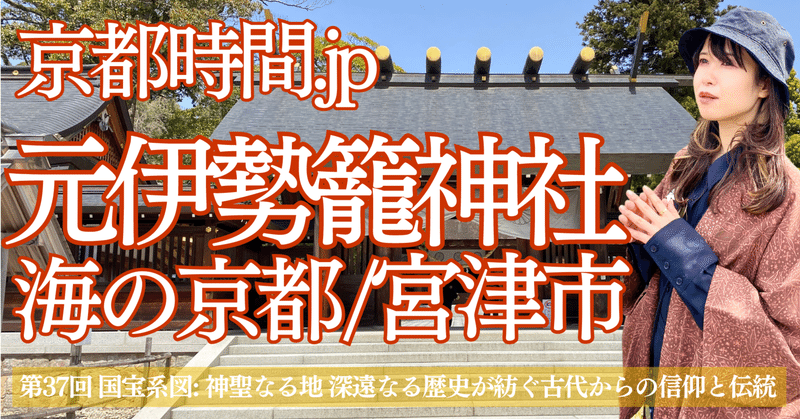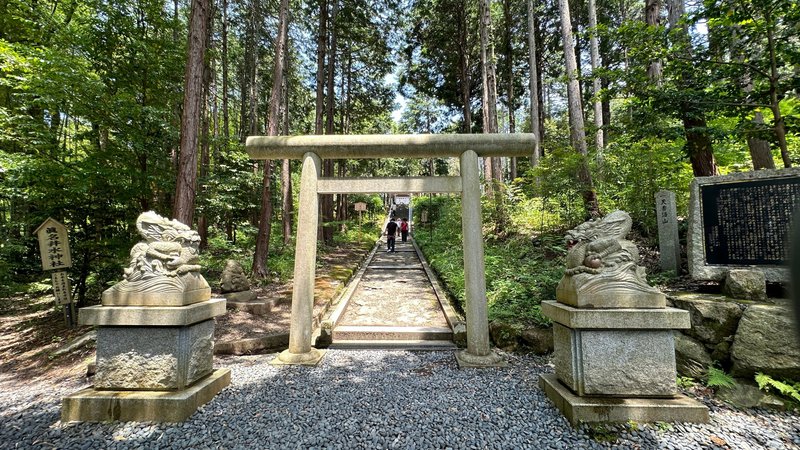
【京都時間.jp】第37回 国宝系図: 神聖なる地 深遠なる歴史が紡ぐ古代からの信仰と伝統
元伊勢籠神社の歴史とその神秘性は、京都府宮津市に根ざし、古代日本の信仰心と文化的伝統を現代に伝える貴重な遺産です。この神社は、その起源、御祭神、由緒、社殿様式、そして社会的・宗教的地位を通じて、深い歴史的意味合いを持ちます。そしてこの神社に伝わる海部氏系図は、平安時代初期に書写された日本最古の国宝系図で、始祖から平安初期までの直系当主を簡潔に記しています。稲荷山鉄剣銘に類似した形式をもち、古い形を今に伝える貴重な史料となっています。

御祭神と神話の背景
元伊勢籠神社の主祭神、彦火明命は、日本神話における重要な神格の一つであり、豊かな自然と人々の生活を支える神として崇拝されています。彼の存在は、古代人が自然界と調和しながら生活を営んでいたことを示し、稲作や養蚕などの農業技術を広めたとされる故事は、人々の生活に直接影響を与えた神としての重要性を物語っています。彦火明命をはじめ、豊受大神や天照大神などの相殿の神々は、豊穣、繁栄、そして自然への敬意を象徴し、古代からの信仰を今に伝えます。

神社の由緒と歴史的変遷
元伊勢籠神社の由緒は、神代から続く深い歴史を持ち、特に伊勢神宮との関連性は、日本の神道信仰におけるこの神社の特別な位置づけを示しています。天照大神と豊受大神が一時期共に祀られた後、それぞれ伊勢に遷されたことで、「元伊勢」という名称が与えられました。この背景には、日本古来の神々への深い敬意と、神聖なる地としての認識があります。神社が伊勢神宮と深い結びつきを持つことは、その宗教的、文化的重要性を際立たせます。

社殿様式と文化的意義
社殿は神明造りの様式で建てられており、伊勢神宮の建築様式を踏襲しています。この点は、元伊勢籠神社が伊勢神宮と深い関連を持つことの証であり、神社建築における重要な文化遺産としての価値を持ちます。特に五色の座玉は、神社建築史上でも非常に珍しく、神聖なる場所の象徴としての役割を果たしています。これらの特徴は、古代からの信仰と伝統が今に続くことの証しであり、文化的にも重要な意味を持ちます。

「一の宮」としての社会的・宗教的地位
元伊勢籠神社が「一の宮」として、また丹後国の総社としての地位を有することは、この神社が地域社会における中心的な宗教施設であったことを示します。一の宮としての地位は、その地域で最も由緒ある神社としての認識を意味し、総社としては地域内の全ての神々を祀る役割を担っていました。これは、元伊勢籠神社が古代から現代に至るまで、人々の信仰生活の中心であったことを示しています。

神話と伝承に根ざした名称の起源
元伊勢籠神社の名称は、彦火明命が海神の宮へ籠船に乗って行ったという神話に由来します。この故事は、人々が自然現象や神々の世界をどのように解釈し、その物語を通じて文化や信仰を形成してきたかを示しています。海との関連性は、この地域の人々にとって海が生活と信仰において重要な要素であったことを物語っています。

古代の祭祀形態と現代への継承
古代の祭祀形態と現代への継承を深く考察することは、私たちが過去と現在をつなぐ不可欠な架け橋を理解する上で重要です。磐座や天の眞名井の水など、元伊勢籠神社に残る古代の祭祀形態を通して、古代人が自然界とどのように向き合い、神々を崇拝してきたかが伝わってきます。これらの形態は、ただ単に過去の遺産としてではなく、自然との深い結びつきや神聖なるものへの敬意を現代にも伝えるメッセージとして機能しています。

特に注目すべきは、これらの祭祀形態が示す自然との調和と尊重です。古代人は、自然界が持つ力と神聖さを深く理解し、それを崇拝の形で表現していました。磐座や天の眞名井の水といった自然要素を神聖視することで、彼らは自然界全体と神々との間に深い結びつきを感じ、それを生活の中で大切にしていました。このような自然への畏敬の念は、現代においても非常に価値のある教訓を私たちに与えています。現代社会が直面する環境問題や自然との関係性の再考において、古代の知恵が示す自然との調和の精神は、新たな指針を提供するかもしれません。

元伊勢籠神社を訪れることは、単に古代の信仰や文化に触れること以上の意味を持ちます。それは、過去と現在、自然と人間との関係を深く考察し、これからの生き方について考える機会を与えてくれるのです。古代の祭祀形態から現代へと継承される信仰は、時間を超えて価値を持ち続ける文化的遺産であり、私たち自身のアイデンティティや生活のあり方に深く影響を与える可能性があります。このように、古代からの伝統と信仰に触れることは、私たちが自己のルーツを理解し、現代の生活においてより豊かな精神的な基盤を築くための貴重な機会を提供してくれるのです。
National Treasure Genealogy: The Sacred Land - Ancient Beliefs and Traditions Woven by Profound History
The history and mystique of the Moto-Ise Kago Shrine, rooted in Miyazu City, Kyoto Prefecture, represent a precious heritage that conveys the religious devotion and cultural traditions of ancient Japan to the present day. This shrine holds deep historical significance through its origins, enshrined deities, history, architectural style, and its social and religious status. The Abe clan genealogy, passed down at this shrine, is Japan's oldest national treasure genealogy written in the early Heian period, succinctly documenting the direct lineage of chieftains from its founder to the early Heian period. Similar in format to the Inariyama Sword Inscription, it serves as a valuable historical document that conveys ancient forms to the present.
Deities and Mythological Background
The main deity of Moto-Ise Kago Shrine, Hikohohodemi no Mikoto, is one of the significant deities in Japanese mythology, worshipped for supporting the lush nature and the livelihood of people. His existence signifies the ancient people's harmonious life with nature, spreading agricultural techniques such as rice cultivation and sericulture, illustrating his importance as a deity directly influencing people's lives. Hikohohodemi no Mikoto, along with other deities like Toyotama-hime and Amaterasu Omikami, symbolizes fertility, prosperity, and respect for nature, conveying ancient beliefs to the present.
Shrine's Historical Transition and Significance
The Moto-Ise Kago Shrine's history, deeply rooted since the age of the gods, especially its connection to the Ise Grand Shrine, highlights its unique position in Japan's Shinto beliefs. After Amaterasu Omikami and Toyotama-hime were enshrined together for a period before being moved to Ise, the name "Moto-Ise" was given, reflecting deep respect for Japan's ancient deities and recognition of the land as sacred. The shrine's deep ties with the Ise Grand Shrine underscore its religious and cultural importance.
Architectural Style and Cultural Significance
The shrine is built in the Shinmei-zukuri architectural style, following the Ise Grand Shrine's style, evidencing Moto-Ise Kago Shrine's deep connection to the Ise Grand Shrine and its value as an important cultural heritage in shrine architecture. Particularly, the rare five-colored seating stones symbolize the shrine as a sacred place, proving the continuation of ancient beliefs and traditions and their cultural importance today.
Social and Religious Status as "Ichinomiya"
Moto-Ise Kago Shrine's status as "Ichinomiya" and the total shrine of Tango Country signifies its central role in the community's religious facilities. Being "Ichinomiya" means recognition as the most prestigious shrine in the area, and as the total shrine, it plays the role of enshrining all local deities, indicating its central position in people's religious lives from ancient times to the present.
Origin of the Name Rooted in Mythology and Tradition
The name Moto-Ise Kago Shrine derives from the myth of Hikohohodemi no Mikoto sailing to the sea god's palace, showing how people interpreted natural phenomena and the divine world, shaping culture and beliefs through these stories. The association with the sea indicates the importance of the sea in the lives and faith of the local people.
Continuation of Ancient Ritual Forms to the Present
Deeply considering the ancient ritual forms and their continuation to the present is crucial for understanding the indispensable bridge connecting our past and present. Ancient ritual forms at Moto-Ise Kago Shrine, such as rock seats and the water of Ame-no-Manai, convey how ancient people faced nature and worshipped deities, functioning not just as heritage but as a message conveying deep connections with nature and respect for the sacred.
Especially noteworthy is the harmony and respect for nature these ritual forms demonstrate. Ancient people deeply understood the power and sanctity of nature, expressing their worship through these forms. By sanctifying natural elements like rock seats and the water of Ame-no-Manai, they felt a deep connection between the natural world and deities, valuing this in their lives. This reverence for nature offers valuable lessons for contemporary society, potentially providing new guidelines for reconsidering our relationship with the environment and natural harmony based on ancient wisdom.
Visiting Moto-Ise Kago Shrine offers more than just an encounter with ancient beliefs and culture; it invites deep reflection on the past and present relationships between nature and humans, contemplating our way of living. The faith passed down from ancient ritual forms to the present holds enduring value as a cultural heritage, deeply influencing our identity and way of life. Engaging with ancient traditions and beliefs provides a precious opportunity to understand our roots and build a richer spiritual foundation in modern life.
この記事が気に入ったらサポートをしてみませんか?
